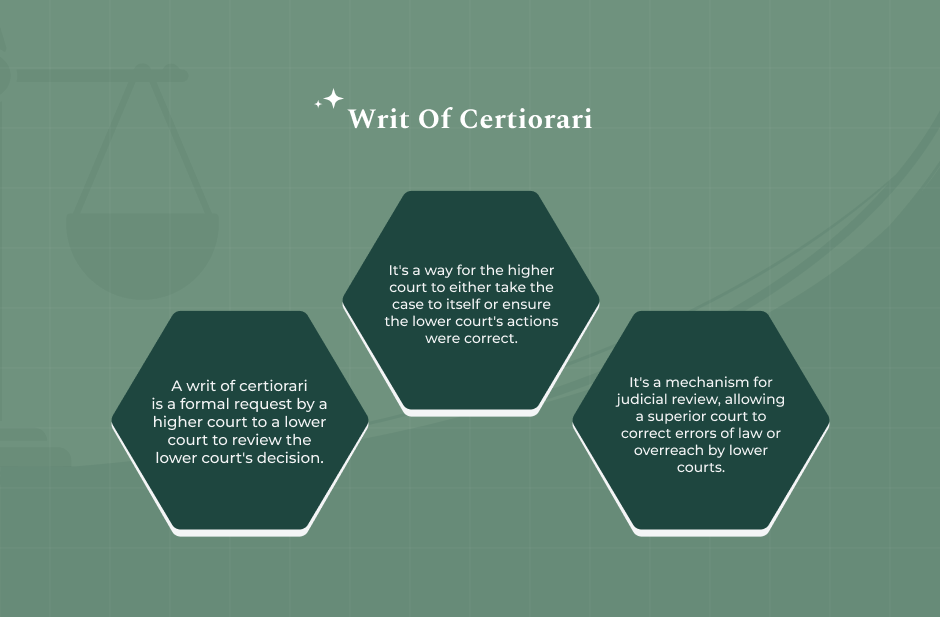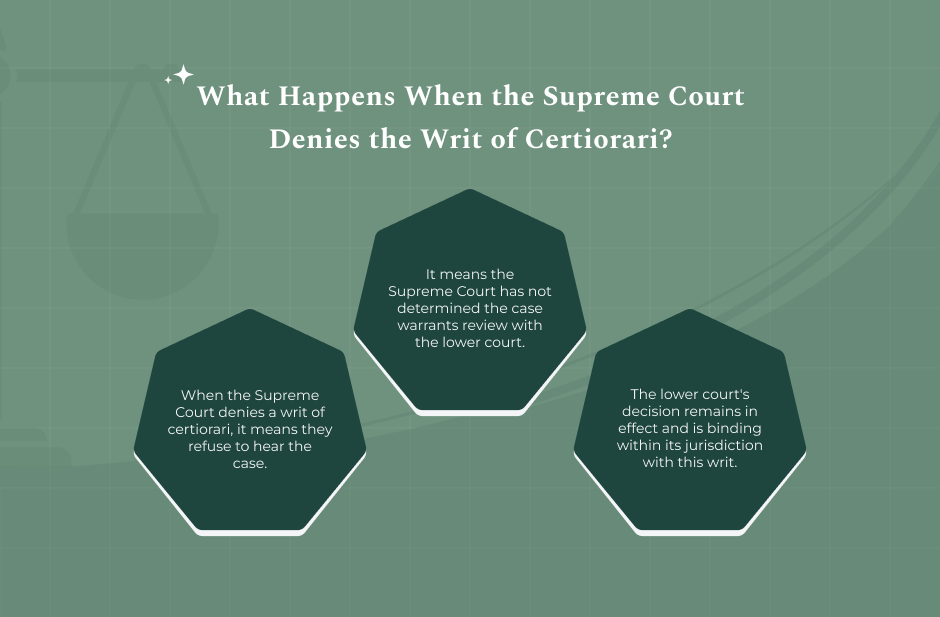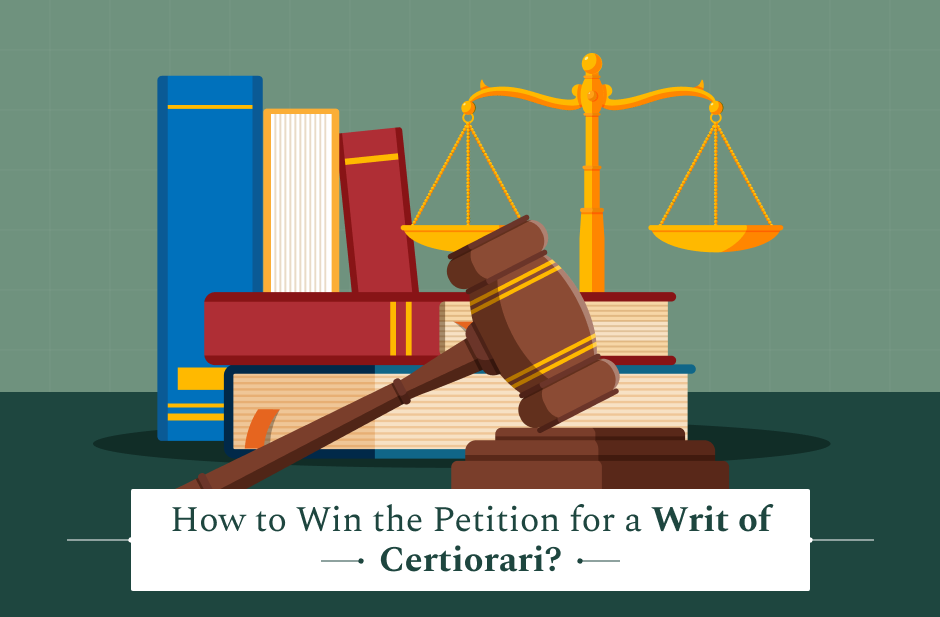The Writ of Certiorari might sound like a big, scary phrase, but it simply means asking the highest court in the country—the U.S. Supreme Court—to look at your case.
People usually do this when they believe a lower court made a serious mistake and want a final review.
But it’s not as easy as just asking; you need to explain why your case matters not just to you, but to others, too.
But hey, that’s what I am here for.
Through this blog, I am here to explain everything to you in the simplest way possible! And yes, in case you are wondering what all you are hoping to learn through this blog, let me brief you a little!
I will explain:
- What the writ of certiorari is.
- When and why it gets accepted or denied.
And that’s not all! I will also tell you how you can increase your chances of the Supreme Court saying, “Yes, we’ll look at your case.”
So, if you or someone you know is thinking of filing one, keep reading!
What is the Writ of Certiorari?

Let’s break it down. “Writ” just means a written order. “Certiorari” means “to be more fully informed.”
So, a Writ of Certiorari is an order from the Supreme Court saying, “Send us the full record of this case because we want to review it.”
People usually ask for this when they think the lower courts (like a state court or a federal appeals court) made a big legal mistake.
But here’s the twist—the Supreme Court does not have to take the case. They get thousands of petitions every year and only pick a few. That’s why it’s important to understand how and when to file it properly.
When Should You Appeal?
Before you jump into filing a petition for a Writ of Certiorari, you need to make sure your case is ready. That means:
- You already went through all the lower courts.
- The last court, usually a court of appeals, gave you a final answer.
- You strongly believe the court made a legal error that affects more than just you.
It’s not enough to say the court was unfair. You need a serious legal issue that might affect people in similar situations or show a conflict in how courts interpret the law.
Elements of Writ of Certiorari
If you want your petition to be accepted, there are a few key parts that must be there:
- Questions Presented: This is where you write the big legal question you want the Court to answer. Keep it clear and focused.
- Statement of the Case: Give a short version of what happened in your case.
- Reasons for Granting the Writ: This is where you explain why your case is important for the Court to look at.
- Appendix: This includes court opinions and important documents that support your argument.
Each part needs to be written clearly and follow the Supreme Court’s rules. Even a small mistake in formatting or word count can get your petition rejected.
What are the Reasons for Granting a Writ of Certiorari?
The Supreme Court only picks cases that matter to the country, not just to the people involved. Here are the most common reasons they say yes:
- Split in decisions: When different courts have given different answers to the same legal question.
- Important federal question: When your case raises a serious question about federal law or the U.S. Constitution.
- Mistake by a lower court: If a court clearly went against a Supreme Court decision or made a legal error.
- National impact: If your case affects a lot of people or important issues (like voting rights or free speech).
The Court wants to make sure the law is the same for everyone. So, if your case can help clear confusion or set a standard, you’re more likely to get their attention.
What are the Reasons for Denying a Writ of Certiorari?
Now let’s talk about why the Court says no—which happens most of the time:
- No major legal question: Your case may not raise a big enough issue for the whole country.
- Too personal: If your case affects only you and doesn’t set a bigger legal example.
- Already answered: If the Court has already handled a similar issue.
- Bad record: If the lower courts didn’t fully discuss the legal question or your petition isn’t well-written.
And sometimes, they simply don’t have room to hear more cases. So, a denial doesn’t mean your case was wrong—it just wasn’t chosen.
What Happens When the Supreme Court Denies the Writ of Certiorari?

If the Court denies your petition, that’s it. The decision from the lower court stands. It means the Supreme Court will not hear your case, and you must live with the last ruling you got.
But don’t worry—it does not mean they think you’re wrong. The Court only hears about 1% of the petitions it gets. So, your case might still be valid; it just wasn’t selected.
Sometimes, people try to re-file or bring a similar case later, but most of the time, the journey ends there. That’s why it’s so important to make your petition strong the first time.
Is There Any Difference Between Certiorari and Appeal?
Yes, there’s a big difference!
- An appeal is something you have a right to do. If a lower court rules against you, you can ask a higher court to look at it again.
- A petition for certiorari, on the other hand, is something you must ask permission for. The Supreme Court doesn’t have to say yes.
Think of it like this:
- An appeal is like saying, “I demand another look.”
- A certiorari petition is like saying, “I respectfully ask the Supreme Court to consider reviewing this.”
Also, appeals often focus on fixing mistakes in your case. But a writ of certiorari focuses more on important questions of law.
Your Legal Guide: How to Win a Petition for Writ of Certiorari?
Now let’s talk about what you really want to know: how to improve your chances of winning.
Here are some tips:
1. Pick the Right Case
Not every case should go to the Supreme Court. Make sure yours involves a major legal question, especially if it has national importance or involves a disagreement between courts.
2. Keep It Short and Clear
The Justices and their clerks read thousands of petitions. Make yours easy to read. Use short sentences, clear headings, and get to the point fast.
3. Highlight the Conflict
If different courts have given different answers to the same question, say so! That’s one of the top reasons the Court will take your case.
4. Show the Bigger Picture
Explain how your case could help many people, not just you. The Court wants to make laws clearer for everyone.
5. Get a Legal Expert
The process has many rules. If you can, get a lawyer who has filed a Supreme Court petition before. A professional touch makes a big difference.
6. Follow the Rules Perfectly
The Supreme Court has strict rules about how petitions must be written and filed. Even a small mistake—like using the wrong font or paper size—can get your petition thrown out.
7. Be Honest and Respectful
Always tell the truth about your case. Don’t exaggerate. And always be respectful in your writing, even if you think the lower court made a big mistake.
Read Also:















